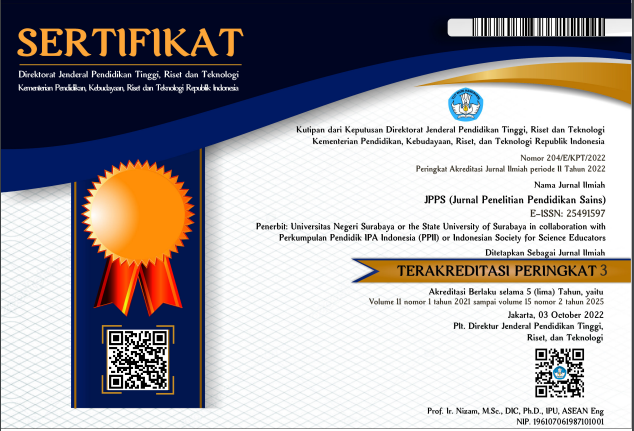INVESTIGATING STUDENTS CRITICAL THINKING DISPOSITION BASED ON GENDER IN PHYSICS TEACHING WITH INTERACTIVE MULTIMEDIA
DOI:
https://doi.org/10.26740/jpps.v9n1.p1766-1771Keywords:
Critical Thinking Disposition, Gender, Interactive MultimediaAbstract
Interactive multimedia is able to combine various kinds of representations into one whole media unit. These representations are in the form of visual, auditory, and procedural representations. Interactive multimedia capabilities can directly stimulate the development of students' critical thinking skills. This research has explored the increasing tendency of students to think critically or called critical thinking disposition. In particular, this study compared the increasing levels of critical thinking disposition of male and female students. Field trials employed a quasi-experiment with a pretest and posttest control group design. The subject consisted of 16 male and 16 female students in senior high school at Mataram, Indonesia. The research instrument used description problem that has been adapted to the indicators of critical thinking disposition, namely truth-seeking, open-mindedness, analyticity, systematic, and inquisitiveness. The results indicate that of N-gain research for male students were 35.5 and female 36.4. This shows that the use of interactive multimedia has a positive effect on improving critical thinking disposition in both male and female students.Downloads
Download data is not yet available.
References
<p>Apriyanti, L., Abdurrahman, A., & Viyanti, V. (2014). Pengaruh Disposisi Berpikir Kritis Terhadap Hasil Belajar Melalui Arias Terpadu Peta Konsep. <em>Jurnal Pembelajaran Fisika</em>, 2(4), 39-51.</p><p>Cronbach, L. J. (1990). <em>Essentials of psychological testing.</em> New York: Harper Collins.</p><p>Dewey, J. (1933). <em>How We Think: A Restatement of the Relation of Reflective Thinking to the Educational Process</em>. Lexington, MA: Heath Publishing. Originally published in 1910.</p><p>Facione, P. A. (2000). The disposition toward critical thinking: Its character, measurement, and relationship to critical thinking skill. <em>Informal logic</em>, 20(1), 61-84.</p><p>Facione, P. A., Sanchez, C. A., Facione, N. C., & Gainen, J. (1995). The disposition toward critical thinking. <em>The Journal of General Education</em>, 44(1), 1-25.</p><p>Giancarlo, C. A., and Facione, P. A. (2001). A look across four years at the disposition toward critical thinking among undergraduate students. <em>J. Gen. Educ</em>. 50(1), 2955.</p><p>Gunawan, G., & Liliasari, L. (2012). Model Virtual Laboratory Fisika Modern untuk Meningkatkan Disposisi Berpikir Kritis Calon Guru. <em>Jurnal Cakrawala Pendidikan</em>, 31(2).185-199.</p><p>Gunawan, G., Harjono, A., & Sutrio, S. (2017). Multimedia Interaktif dalam Pembelajaran Konsep Listrik bagi Calon Guru. <em>Jurnal Pendidikan Fisika dan Teknologi</em>, 1(1), 9-14.</p><p>Gunawan, G., Suranti, N. M. Y., Nisrina, N., Herayanti, L., & Rahmatiah, R. (2018). The effect of virtual lab and gender toward students creativity of physics in senior high school. <em>In Journal of Physics: Conference Series</em> 1108 (1), 012043.</p><p>Halpern, D. F. (1998). Teaching critical thinking for transfer across domains: Disposition, skills, structure training, and metacognitive monitoring. <em>American psychologist</em>, 53(4), 449.</p><p>Hazari, Z., Tai, R. H., & Sadler, P. M. (2007). Gender differences in introductory university physics performance: The influence of high school physics preparation and affective factors. <em>Science Education</em>, 91(6), 847-876.</p><p>Hosnan, M. (2014). <em>Pendekatan saintifik dan kontekstual dalam pembelajaran abad 21</em>. (Scientific and contextual approach to 21 century learning) Jakarta: Ghalia Indah</p><p>Husein, S., Herayanti, L., & Gunawan, G. (2017). Pengaruh Penggunaan Multimedia Interaktif Terhadap Penguasaan Konsep dan Keterampilan Berpikir Kritis Siswa pada Materi Suhu dan Kalor. <em>Jurnal Pendidikan Fisika dan Teknologi</em>, 1(3), 221-225.</p><p>Hwang, G. J., & Wu, P. H. (2014). Applications, impacts and trends of mobile technology-enhanced learning: a review of 20082012 publications in selected SSCI journals. <em>International Journal of Mobile Learning and Organisation</em>, 8(2), 83-95.</p><p>Irani, T., Rudd, R., Gallo, M., Ricketts, J., Friedel, C., & Rhoades, E. (2007). Critical thinking instrumentation manual. <em>Retrieved August</em>, <em>11</em>, 2011.</p><p>Kenway, J., & Gough, A. (1998). Gender and science education in schools: a review ˜with attitude. <em>Studies in Science Education</em>, 31(1998), 1-30.</p><p>Khan, F. M. A., & Masood, M. (2015). The effectiveness of an interactive multimedia courseware with cooperative mastery approach in enhancing higher order thinking skills in learning cellular respiration. <em>Procedia-Social and Behavioral Sciences</em>, 176, 977-984.</p><p>Mashami, R. A., & Gunawan, G. (2018). The Influence of Sub-Microscopic Media Animation on Students' Critical Thinking Skills Based on Gender. <em>In Journal of Physics: Conference Series</em> 1108 (1), 012106.</p><p>Pluck, G., & Johnson, H. L. (2011). Stimulating curiosity to enhance learning. <em>GESJ: Education Sciences and Psychology</em>, 2(19), 24-31.</p><p>Quitadamo, I. J., & Kurtz, M. J. (2007). Learning to improve: using writing to increase critical thinking performance in general education biology. <em>CBE”Life Sciences Education</em>, 6(2), 140-154.</p><p>Rahmatiah, R., Gunawan, G., & Sutrio, S. (2013). Model Pembelajaran Berbasis Multimedia Interaktif (MMI) untuk Meningkatkan Penguasaan Konsep dan Keterampilan Berpikir Kritis Siswa pada Materi Optik. <em>Lensa: Jurnal Kependidikan Fisika</em>, 1(2), 86-94.</p><p>Walker, S. E. (2003). Active learning strategies to promote critical thinking. <em>Journal of athletic training</em>, 38(3), 263.</p><p>Walsh, C. M., & Hardy, R. C. (1999). Dispositional differences in critical thinking related to gender and academic major. <em>Journal of Nursing Education</em>, 38(4), 149-155.</p>
Downloads
Additional Files
Published
2020-01-17
How to Cite
Gunawan, G., Harjono, A., Herayanti, L., Husein, S., & Fathoroni, F. (2020). INVESTIGATING STUDENTS CRITICAL THINKING DISPOSITION BASED ON GENDER IN PHYSICS TEACHING WITH INTERACTIVE MULTIMEDIA. JPPS (Jurnal Penelitian Pendidikan Sains), 9(1), 1766–1771. https://doi.org/10.26740/jpps.v9n1.p1766-1771
Issue
Section
Implementation of Digital Technology in Science Education
 Abstract views: 978
,
Abstract views: 978
, PDF Downloads: 871
,
PDF Downloads: 871
, PDF Downloads: 0
,
PDF Downloads: 0
, PDF Downloads: 0
PDF Downloads: 0












